A subcutaneous (say "sub-kyoo-TAY-nee-us") shot is an injection of medicine under the skin, but not in a muscle. Some medicines, such as insulin and some kinds of blood-thinners, are injected only under the skin. This type of shot is usually given in the belly or the thigh.
How to give yourself the shot
Follow your health professional's instructions for how to give yourself a shot. Here are some general steps for how to do it.
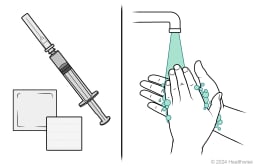
1. Gather your equipment. This includes your syringe (containing medicine) and an alcohol wipe. Wash your hands with soap and water.

2. Choose a spot on your belly or thigh for the shot. Each time, use a slightly different spot. Clean the skin with the alcohol wipe, and let it dry.
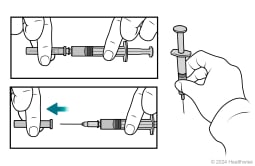
3. Remove the cap from the needle, and hold the syringe like a pencil close to the site. Keep your fingers off the plunger.
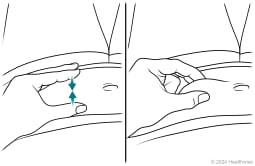
4. Slightly pinch a fold of skin at the spot you chose. Pinch it between the fingers and thumb of your other hand.
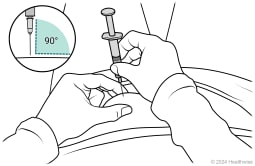
5. Place the syringe at a 90-degree angle to the shot site. The needle should stand straight up from the skin.
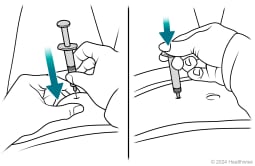
6. Quickly push the needle all the way into the pinched-up fold of skin. Then push the plunger all the way in. Let go of the skin fold.

7. Take the needle out at the same angle that you inserted it. If you bleed a little, apply pressure over the shot area. You can use your finger, a cotton ball, or gauze.

8. Dispose of the needle safely. Don't use the same needle more than once.
When should you call for help?
Watch closely for changes in your health, and be sure to contact your doctor if you are having problems with your injections or have skin changes at the injection sites.
Follow-up care is a key part of your treatment and safety. Be sure to make and go to all appointments, and call your doctor if you are having problems. It's also a good idea to know your test results and keep a list of the medicines you take.
Where can you learn more?
Go to http://www.healthwise.net/patientEd
Enter Y984 in the search box to learn more about "How to Give Yourself a Subcutaneous Shot: Care Instructions".
Current as of: October 25, 2024
Author: Ignite Healthwise, LLC Staff
Clinical Review Board
All Ignite Healthwise, LLC education is reviewed by a team that includes physicians, nurses, advanced practitioners, registered dieticians, and other healthcare professionals.

